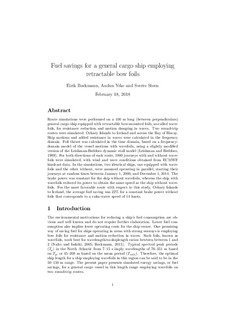| dc.contributor.author | Bøckmann, Eirik | |
| dc.contributor.author | Yrke, Audun | |
| dc.contributor.author | Steen, Sverre | |
| dc.date.accessioned | 2018-04-23T06:43:56Z | |
| dc.date.available | 2018-04-23T06:43:56Z | |
| dc.date.created | 2018-04-22T11:31:01Z | |
| dc.date.issued | 2018 | |
| dc.identifier.citation | Applied Ocean Research. 2018, 76 . | nb_NO |
| dc.identifier.issn | 0141-1187 | |
| dc.identifier.uri | http://hdl.handle.net/11250/2495380 | |
| dc.description.abstract | Route simulations were performed on a 100 m long (between perpendiculars) general cargo ship equipped with retractable bow-mounted foils, so-called wavefoils, for resistance reduction and motion damping in waves. Two round-trip routes were simulated: Orkney Islands to Iceland and across the Bay of Biscay. Ship motions and added resistance in waves were calculated in the frequency domain. Foil thrust was calculated in the time domain, based on a frequency-domain model of the vessel motions with wavefoils, using a slightly modified version of the Leishman–Beddoes dynamic stall model [22]. For both directions of each route, 1000 journeys with and without wavefoils were simulated, with wind and wave conditions obtained from ECMWF hindcast data. In the simulations, two identical ships, one equipped with wavefoils and the other without, were assumed operating in parallel, starting their journeys at random times between January 1, 2000, and December 1, 2014. The brake power was constant for the ship without wavefoils, whereas the ship with wavefoils reduced its power to obtain the same speed as the ship without wavefoils. For the most favorable route with respect to this study, Orkney Islands to Iceland, the average fuel saving was 22% for a constant brake power without foils that corresponds to a calm-water speed of 14 knots. | nb_NO |
| dc.language.iso | eng | nb_NO |
| dc.publisher | Elsevier | nb_NO |
| dc.relation.uri | https://www.sciencedirect.com/science/article/pii/S0141118717304091 | |
| dc.title | Fuel savings for a general cargo ship employing retractable bow foils | nb_NO |
| dc.type | Journal article | nb_NO |
| dc.description.version | submittedVersion | nb_NO |
| dc.source.pagenumber | 10 | nb_NO |
| dc.source.volume | 76 | nb_NO |
| dc.source.journal | Applied Ocean Research | nb_NO |
| dc.identifier.doi | 10.1016/j.apor.2018.03.015 | |
| dc.identifier.cristin | 1580840 | |
| dc.relation.project | Norges forskningsråd: 216432 | nb_NO |
| dc.description.localcode | This is a submitted manuscript of an article published by Elsevier Ltd in Applied Ocean Research, 21 April 2018 | nb_NO |
| cristin.unitcode | 194,64,20,0 | |
| cristin.unitname | Institutt for marin teknikk | |
| cristin.ispublished | true | |
| cristin.fulltext | preprint | |
| cristin.qualitycode | 1 | |
